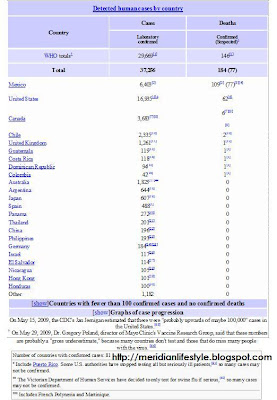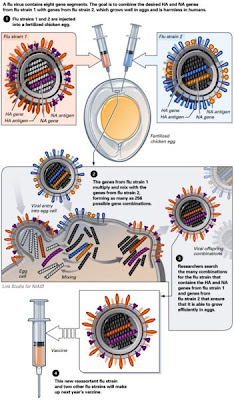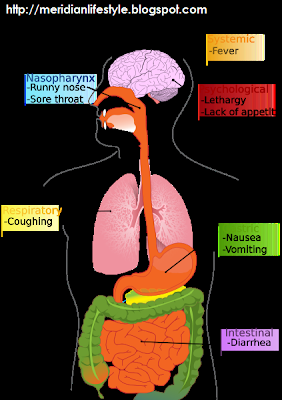Influenza Virus A(H1N1) SWINE FLU
CRYPTOMONADALES/PPARs - Anti-Viral, Immunoregulation & Anti-Inflamation http://cryptomonadalesppar.wordpress.com
Thursday, June 25, 2009
Monday, June 15, 2009
STOP VIRUSES with CRYPTOMONADALES/PPARs
With this present scare we are experiencing because of the fast-spreading virus called A(H1N1), it comes naturally that we find ourselves panicky and alarmed. At present, people who have been found to possess the virus have increased drastically due to the fact that more and more have been willing to subject themselves to tests done by medical professionals.
Medical institutions have been on the alert for new cases concerning this virus and the more popular institutions known to have increased their vigilance are schools and universities, most especially now that school has just started a few days back.
People who are known to have been inflicted by the virus show signs of fever, sore throat and weakness and all the others that closely resemble the common flu. As most medical professionals have disclosed, those with low body resistance are those easily afflicted by the virus. As advice being given by doctors and health specialists, the best chance in avoiding this predicament is to start strengthening our immunity system.
This is where CRYPTOMONADALES take action. Due to its components, CRYPTOMONADALES provides the immunity our bodies need to fight off viral and bacterial diseases and in times of actual illnesses, cures them as an immediate reaction.

You will find further details of its components as you further read on and as it is well explained. As a foreword, CRYPTOMONADALES has been tested to be effective in curing the more advanced stage of this virus which is called H5N1. For further information, kindly proceed by going through what is about to be explained technically about this H5 strain and how CRYPTOMONADALES reacts as an effective counter and cure.
Algae (Chlorella Sorokiniana brand name –CRYPTOMONADALES) is currently being evaluated by International Chlorella (Dr. Wang-Sponsor) for its potential as prophylaxis against avian Influenza virus H5N1 infection of humans.
Studies performed at ViroClinics B.V., Rotterdam, where ferrets were infected with different H5N1 strain (unpublished) demonstrated that the infection of ferrets with Influenza H5N1viruses can be use for the pre-clinical evaluation of countermeasures for these infections in humans.
Recently, the Sponsor has demonstrated that the green algae Chlorella Sorokiniana, contains agonists of peroxisome proliferators activated receptors (PPARs). PPARs are widely recognized as the molecular drug targets for many diseases including hyperglycemia, diabetes, obesity and cancer. Upon activation by endogenous or synthetic ligands PPAR regulate the expression of target genes involved in a variety of important physiological pathways such as lipid metabolism, insulin sensitivity, cells differentiation, inflammation, proliferation, and apoptosis. PPAR agonists have been reported to exhibit immunomodulatory effects on the activation of T cells and macrophages and the suppression of proinflammatory cytokines secretion. Futhermore, in a prelimenary report Sponsor showed an inhibitory effect on virus reflication by PPAR agonists using a rabbit model for virus-associated hemophagocytic syndrome (VAHS), a cytokine disorder in response to virus infection.
The in-life phase of the present study was conducted at ViroClinics BV, Room Ee 1989 Erasmus Medical Centre, Rotterdam, for the Sponsor. Gross Pathology and histopathology analysis was conducted by Prof. Dr. Thijs Kuiken, Department of Virology, Erasmus Medical Centre, Rotterdam, The Netherland. Virological analyses were conducted by ViroClinics BV.
Link to http://influenzavirus-swineflu.blogspot.com/2009/06/blog-post.html to view the actual results of the research and studies back up by actual testing.
For those who are looking for the most complete health enhancer, Cryptomonadales is the perfect product for you. Feel more energetic, with the most nutritionally complete food available in the market, and experience a boost in your health.
Cryptomonadales, developed by Dr. Shun-Te Wang in the 1990s, has been hailed as one of the most promising health food in the 21st century. It has been researched by Asia’s most prominant medical researchers, and is even recognized by the Government of Taiwan.
What is Cryptomonadales?
Cryptomonadales is a thermophilic strain of Chlorella sorokiniana, yet DIFFERENT from any know strain when examined by RAPD (Random Amplified Polyorphic DNA analysis). The RAPD analysis shows the UNIQUENESS of Cryptomonadales (strain W87-10), distinctly different from the other strains of chlorella sorokiniana.
Cryptomonadales is also the perfect food therapy for those who want to nourish themselves for therapeutic reasons. The PPAR content in Cryptomonadales will help initiate your body’s immune system. It’s rich nutritional profile, chlorophyll content, Anti-oxidant profile, and Phycocyanin provides the body with the resources it needs for cleansing, repair and nourishment.
Cryptomonadales is Nature Life Science’s unique formulation of green algae cultured by Professor Wang Sun Te, the world’s foremost researcher in biotechnology and algae culture. This unique formulation was intensely researched and studied by the National Health Research Institute and Institute of Technology and Information Science in Taiwan, primarily for its pharmacological promise in treatment of illnesses and preventive functions.
Cryptomonadales is an over single cell organism similar to the human red blood cell. Average cell size is 2-8 micron, and has a thin cell wall which allow 95% digestibility within 1 to 2 hours.
Cryptomonadales is the world most complete source of phytonutrients, rare minerals and therapeutic components:
1. PPAR
2. Phycocyanin
3. CGF (Chlorella/Cell Growth Factor)
4. Anti-oxidant
5. Chlorophyll
6. Complete nutrient spectrum
“The data and findings presented above indicate that Crytomonadales is not only the most ideal species of algae containing the full nutrition elements for humans since thousands of years before, far better than other species of chlorella and spirulina, but also, recent studies confirm that Cryptomonadales contains the valuable components like phycocyanin and PPARs agonists, both represent the most promising essential nutrition for the 21st century. It will be a privilege for us to own this precious species of algae. I believe that Cryptomonadales will become the most prevailing health food in the 21st century.”
Ih-Jen Su, MD, PhD, Professor and Distinguished Investigators, Division of Clinical research, NHRI, Tainan, Taiwan (Book Cryptomonadales and PPARs)
A TRULY AMAZING Nutrition Profile!
Cryptomonadales contains rich nutrition for the human body, and amazingly its NATURAL components and nutrition ratio is ideal for the specific demands of our body.

Cryptomonadales which is rich in proteins and essential amino acids. It contains high amounts of natural vitamins like Beta-carotene, vitamin A, B, C and E, all of which are necessary to maintain our growth and health. It is also rich in minerals like selenium which is believed to have anti-cancer properties. Unlike other animal products or synthetic food, all nutrients of Crypto+ are botanical, organic, and are absorbed suitably by the body without side effect. Most importantly, Cryptomonadales contains natural phycocyanin and PPARs agonists.

The Cryptomonadales Difference - More than just Vitamins and Minerals! Cryptomonadales is not only a complete food...it is a healing food.
- CGF providing abundant energy for your cells.
- Anti-aging effects through conversion of the human body from acidic to alkaline.
- Blood purification and anti-toxic effect from abundant chlorophyll content (almost 100 times more than normal vegetables).
- Liver function regulation and protection
- Prevention and treatment of chronic diseases through nutrition.
- Anti-Viral, immunoregulation and anti-inflammation.
- Managing blood cholesterol
- Cancer chemoprevention effects of cryptomonadales.
- The miracle of PPARs agonists.



Medical institutions have been on the alert for new cases concerning this virus and the more popular institutions known to have increased their vigilance are schools and universities, most especially now that school has just started a few days back.
People who are known to have been inflicted by the virus show signs of fever, sore throat and weakness and all the others that closely resemble the common flu. As most medical professionals have disclosed, those with low body resistance are those easily afflicted by the virus. As advice being given by doctors and health specialists, the best chance in avoiding this predicament is to start strengthening our immunity system.
This is where CRYPTOMONADALES take action. Due to its components, CRYPTOMONADALES provides the immunity our bodies need to fight off viral and bacterial diseases and in times of actual illnesses, cures them as an immediate reaction.

You will find further details of its components as you further read on and as it is well explained. As a foreword, CRYPTOMONADALES has been tested to be effective in curing the more advanced stage of this virus which is called H5N1. For further information, kindly proceed by going through what is about to be explained technically about this H5 strain and how CRYPTOMONADALES reacts as an effective counter and cure.
Algae (Chlorella Sorokiniana brand name –CRYPTOMONADALES) is currently being evaluated by International Chlorella (Dr. Wang-Sponsor) for its potential as prophylaxis against avian Influenza virus H5N1 infection of humans.
Studies performed at ViroClinics B.V., Rotterdam, where ferrets were infected with different H5N1 strain (unpublished) demonstrated that the infection of ferrets with Influenza H5N1viruses can be use for the pre-clinical evaluation of countermeasures for these infections in humans.
Recently, the Sponsor has demonstrated that the green algae Chlorella Sorokiniana, contains agonists of peroxisome proliferators activated receptors (PPARs). PPARs are widely recognized as the molecular drug targets for many diseases including hyperglycemia, diabetes, obesity and cancer. Upon activation by endogenous or synthetic ligands PPAR regulate the expression of target genes involved in a variety of important physiological pathways such as lipid metabolism, insulin sensitivity, cells differentiation, inflammation, proliferation, and apoptosis. PPAR agonists have been reported to exhibit immunomodulatory effects on the activation of T cells and macrophages and the suppression of proinflammatory cytokines secretion. Futhermore, in a prelimenary report Sponsor showed an inhibitory effect on virus reflication by PPAR agonists using a rabbit model for virus-associated hemophagocytic syndrome (VAHS), a cytokine disorder in response to virus infection.
The in-life phase of the present study was conducted at ViroClinics BV, Room Ee 1989 Erasmus Medical Centre, Rotterdam, for the Sponsor. Gross Pathology and histopathology analysis was conducted by Prof. Dr. Thijs Kuiken, Department of Virology, Erasmus Medical Centre, Rotterdam, The Netherland. Virological analyses were conducted by ViroClinics BV.
Link to http://influenzavirus-swineflu.blogspot.com/2009/06/blog-post.html to view the actual results of the research and studies back up by actual testing.
For those who are looking for the most complete health enhancer, Cryptomonadales is the perfect product for you. Feel more energetic, with the most nutritionally complete food available in the market, and experience a boost in your health.
Cryptomonadales, developed by Dr. Shun-Te Wang in the 1990s, has been hailed as one of the most promising health food in the 21st century. It has been researched by Asia’s most prominant medical researchers, and is even recognized by the Government of Taiwan.
What is Cryptomonadales?
Cryptomonadales is a thermophilic strain of Chlorella sorokiniana, yet DIFFERENT from any know strain when examined by RAPD (Random Amplified Polyorphic DNA analysis). The RAPD analysis shows the UNIQUENESS of Cryptomonadales (strain W87-10), distinctly different from the other strains of chlorella sorokiniana.
Cryptomonadales is also the perfect food therapy for those who want to nourish themselves for therapeutic reasons. The PPAR content in Cryptomonadales will help initiate your body’s immune system. It’s rich nutritional profile, chlorophyll content, Anti-oxidant profile, and Phycocyanin provides the body with the resources it needs for cleansing, repair and nourishment.
Cryptomonadales is Nature Life Science’s unique formulation of green algae cultured by Professor Wang Sun Te, the world’s foremost researcher in biotechnology and algae culture. This unique formulation was intensely researched and studied by the National Health Research Institute and Institute of Technology and Information Science in Taiwan, primarily for its pharmacological promise in treatment of illnesses and preventive functions.
Cryptomonadales is an over single cell organism similar to the human red blood cell. Average cell size is 2-8 micron, and has a thin cell wall which allow 95% digestibility within 1 to 2 hours.
Cryptomonadales is the world most complete source of phytonutrients, rare minerals and therapeutic components:
1. PPAR
2. Phycocyanin
3. CGF (Chlorella/Cell Growth Factor)
4. Anti-oxidant
5. Chlorophyll
6. Complete nutrient spectrum
“The data and findings presented above indicate that Crytomonadales is not only the most ideal species of algae containing the full nutrition elements for humans since thousands of years before, far better than other species of chlorella and spirulina, but also, recent studies confirm that Cryptomonadales contains the valuable components like phycocyanin and PPARs agonists, both represent the most promising essential nutrition for the 21st century. It will be a privilege for us to own this precious species of algae. I believe that Cryptomonadales will become the most prevailing health food in the 21st century.”
Ih-Jen Su, MD, PhD, Professor and Distinguished Investigators, Division of Clinical research, NHRI, Tainan, Taiwan (Book Cryptomonadales and PPARs)
A TRULY AMAZING Nutrition Profile!
Cryptomonadales contains rich nutrition for the human body, and amazingly its NATURAL components and nutrition ratio is ideal for the specific demands of our body.

Cryptomonadales which is rich in proteins and essential amino acids. It contains high amounts of natural vitamins like Beta-carotene, vitamin A, B, C and E, all of which are necessary to maintain our growth and health. It is also rich in minerals like selenium which is believed to have anti-cancer properties. Unlike other animal products or synthetic food, all nutrients of Crypto+ are botanical, organic, and are absorbed suitably by the body without side effect. Most importantly, Cryptomonadales contains natural phycocyanin and PPARs agonists.

The Cryptomonadales Difference - More than just Vitamins and Minerals! Cryptomonadales is not only a complete food...it is a healing food.
- CGF providing abundant energy for your cells.
- Anti-aging effects through conversion of the human body from acidic to alkaline.
- Blood purification and anti-toxic effect from abundant chlorophyll content (almost 100 times more than normal vegetables).
- Liver function regulation and protection
- Prevention and treatment of chronic diseases through nutrition.
- Anti-Viral, immunoregulation and anti-inflammation.
- Managing blood cholesterol
- Cancer chemoprevention effects of cryptomonadales.
- The miracle of PPARs agonists.



Labels:
Anti Viral,
Anti-Inflamation,
Immunoregulation
+SWINE+INFLUENZA+FAQ+(2).jpg)
The 2009 flu pandemic is a global outbreak of a new strain of influenza A virus subtype H1N1, identified in April 2009 and commonly referred to as swine flu, which infects and is transmitted between humans. It is thought to be a mutation —more specifically, a reassortment— of four known strains of influenza A virus subtype H1N1: one endemic in humans, one endemic in birds, and two endemic in pigs (swine). A June 10, 2009 update by the U.N.’s World Health Organization (WHO) states that “74 countries have officially reported 27,737 cases of influenza A(H1N1) infection, including 141 deaths”.
WHO officially declared the outbreak to be a “pandemic” on June 11, but stressed that the new designation was a result of the global “spread of the virus,” not its severity. The WHO stated the pandemic appears to have moderate severity in comparatively well-off countries, however it is prudent to anticipate a bleaker picture as the virus spreads to areas with limited resources, poor health care, and a high prevalence of underlying medical problems. The case fatality rate (CFR) of the pandemic strain is estimated at 0.4% (range 0.3%-1.5%)
The virus typically spreads from coughs and sneezes or by touching contaminated surfaces and then touching the nose or mouth. As of June 2009, there is no vaccine available to prevent infection although companies are developing one; estimates of availability range from six months to twelve months. There is also concern that the virus could mutate later in the year and become more virulent and less susceptible to any vaccine developed to protect from an earlier strain. This concern is partly due to the memory of the 1918 flu pandemic, which killed approximately 600,000 in the United States alone, and was preceded by a mild “herald” wave of cases in the spring.
As of May 24, 2009, nearly 90% of reported deaths had taken place in Mexico. This has led to speculation that Mexico may have been in the midst of an unrecognized epidemic for months prior to the current outbreak, thereby showing a fatality rate that was much higher than it would have been if earlier cases had been counted. According to the US Centers for Disease Control and Prevention, the fact that the flu’s infection activity is now monitored more closely may also help explain why more flu cases than normal are being recorded in many countries.
+Detected+Human+Cases+by+Country.jpg)




+SWINE+INFLUENZA+FAQ.jpg)
+SWINE+INFLUENZA+FAQ+Pg+1.jpg)
+SWINE+INFLUENZA+FAQ+Pg+2.jpg)
+SWINE+INFLUENZA+FAQ+Pg+3.jpg)
+SWINE+INFLUENZA+FAQ+Pg+4.jpg)
Subscribe to:
Posts (Atom)

















